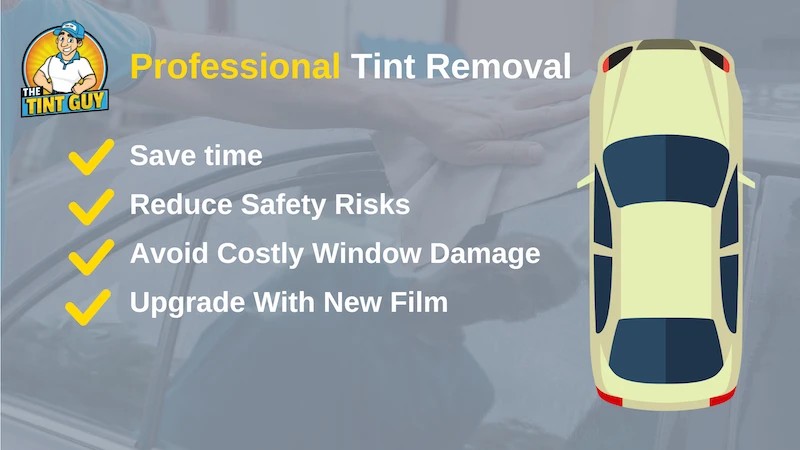Car window tinting offers numerous advantages, from enhanced privacy and UV ray protection to an upgraded aesthetic. However, situations arise where removing window tint becomes necessary. Perhaps your old tint is bubbling or peeling, you’re aiming for a darker or different type of film, or regulations in your area have changed. Removing car tint can seem daunting, but with the right approach, it’s manageable. This guide will walk you through the best methods for taking off tinted windows on your car, covering both DIY techniques and when it’s wise to seek professional help.
DIY vs. Professional Window Tint Removal
Deciding whether to remove window tint yourself or hire a professional is a key first step. Both options have their merits and drawbacks.
DIY Removal: When to Consider It
Taking the DIY route for window tint removal might be appealing if you’re comfortable with hands-on tasks, have some experience with car maintenance, and are looking to save on costs. DIY removal can be suitable for smaller vehicles or single windows, and if you have patience and attention to detail. However, it’s important to be realistic about the time and effort involved.
Professional Removal: Why It’s Often the Better Choice
For many car owners, professional window tint removal is the preferred and often smarter choice. Here’s why:
- Time and Convenience: Removing tint, especially from multiple windows, is time-consuming and physically demanding. Professionals can complete the job efficiently, saving you significant time and effort.
- Damage Prevention: A major risk with DIY removal is damaging your car’s windows. Improper techniques can lead to scratches or even window breakage, which can be costly to repair. Professionals have the expertise and tools to remove tint safely without harming your vehicle. Replacing a windshield or side window can easily run into hundreds of dollars, making professional removal a cost-effective choice in the long run.
- Expertise and Experience: Professionals have experience dealing with various types of window tint and adhesives. They know the best techniques to use for clean removal, minimizing residue and potential window damage.
- New Tint Installation: If you plan to replace your old tint with a new film, using a professional service for both removal and installation is highly convenient. Many tint shops offer package deals or discounts when you combine removal and new installation, potentially saving you money.
- Safety: DIY tint removal involves sharp tools like razor blades and can create dust and debris. Professionals are equipped with safety gear and understand how to handle the process safely, minimizing risks of cuts or respiratory irritation.
While DIY might seem like a money-saving option initially, the potential for damage, wasted time, and the hassle of cleanup often make professional removal a more practical and beneficial solution.
Step-by-Step Guide to DIY Window Tint Removal
If you’ve decided to tackle window tint removal yourself, following the correct procedure is crucial for achieving the best results and minimizing risks. Here’s a step-by-step guide:
1. Gather Your Tools and Materials
Before starting, ensure you have all the necessary tools and materials readily available. This will streamline the process and prevent interruptions. You will need:
- Heat Gun or Hair Dryer: A heat gun is more effective, but a hair dryer can work for smaller areas or thinner films. These tools are essential for loosening the adhesive.
- Razor Blade or Scraper: A new razor blade or plastic scraper will be needed to lift the edge of the tint and peel it away from the window.
- Spray Bottle: For applying cleaning solutions and water.
- Cleaning Solution: Options include isopropyl alcohol, ammonia-based cleaners, specialized adhesive removers, or even soapy water as a less potent alternative.
- Microfiber Cloths: For cleaning windows and wiping away residue.
- Safety Gear: This is critical for personal protection. Include:
- Face Mask: To avoid inhaling dust and debris particles.
- Safety Glasses: To protect your eyes from chemicals and flying debris.
- Safety Gloves: To prevent cuts from the razor blade and protect your skin from cleaning solutions.
2. Prepare Your Workspace and Vehicle
Proper preparation of your workspace and vehicle is important for safety and easier cleanup.
- Ventilation: Choose a well-ventilated area, ideally outdoors or in a garage with the door open. This is crucial due to potential fumes from adhesives and cleaning solutions, as well as dust particles.
- Protection: Lay down tarps or plastic sheeting around your vehicle to catch debris and adhesive residue, simplifying cleanup later.
- Interior Protection: Cover the interior surfaces of your car, especially around the windows, to prevent damage from cleaning solutions or debris.
- Safety Gear: Put on your face mask, safety glasses, and safety gloves before you begin any removal work.
3. Heat the Window Tint
The adhesive holding the window tint film to the glass needs to be softened before removal. Heat is the most effective way to achieve this.
- Expose Tint Edge: Roll down the car window slightly (a few inches) to expose the top edge of the tinted film.
- Apply Heat: Using a heat gun, fabric steamer, or hair dryer, apply heat evenly across the exterior surface of the window where the tint is applied. Hold the heat source a few inches away from the glass and move it back and forth to distribute heat evenly.
- Observe for Curling: Continue heating for several minutes. You should start to see the edges of the tint film begin to curl or peel away from the glass. This indicates the adhesive is loosening. The heating time will vary depending on the type and thickness of the tint, as well as the ambient temperature.
4. Peel Off the Tint Film
Once the edge of the tint starts to lift, you can begin peeling it off.
- Lift the Edge: Use a razor blade or plastic scraper to gently lift the curled edge of the tint film. Be careful not to scratch the glass.
- Peel Slowly and Steadily: Grip the lifted edge of the tint and begin to peel it away from the window. Pull slowly and steadily at a downward angle. Avoid jerking or ripping the film, as this can leave more adhesive residue behind and potentially damage the window.
- Reapply Heat as Needed: If the tint becomes difficult to peel or starts to tear, reapply heat to the area ahead of where you are peeling to further soften the adhesive. Work in sections, heating and peeling gradually.
5. Remove Adhesive Residue
After peeling off the tint film, you will likely be left with adhesive residue on the window. Removing this residue is essential for a clean finish.
- Apply Adhesive Remover: Spray your chosen adhesive remover (isopropyl alcohol, ammonia solution, or commercial adhesive remover) liberally onto the affected areas of the window. Allow it to sit for a few minutes to soften the residue.
- Scrub and Wipe: Use a microfiber cloth or a scraper (plastic to avoid scratching glass) to scrub and loosen the adhesive residue.
- Repeat if Necessary: For stubborn residue, you may need to repeat the application of adhesive remover and scrubbing process multiple times.
- Soapy Water Alternative: Soapy water can be used for less stubborn residue or as a final cleaning step. Apply soapy water, scrub, and wipe clean.
6. Final Window Cleaning
The last step is to thoroughly clean the window to remove any remaining residue and cleaning solutions.
- Clean with Window Cleaner: Use a standard window cleaner and clean microfiber cloths to clean the entire window surface.
- Inspect for Residue: Inspect the window from different angles to ensure all adhesive residue and cleaning solution has been removed.
- Final Wipe: Wipe the window dry with a clean, dry microfiber cloth for a streak-free finish.
Tint Removal Cost
If you opt for professional window tint removal, understanding the potential cost is important for budgeting. The cost of professional tint removal can vary based on several factors:
- Vehicle Type and Size: Larger vehicles with more windows will generally cost more to have tinted removed.
- Number of Windows: Removing tint from all windows will be more expensive than removing tint from just a few.
- Tint Type and Age: Older, thicker, or lower-quality tints can be more difficult to remove, potentially increasing labor costs.
- Shop Rates: Labor rates vary between shops and locations.
However, as a general guideline, professional window tint removal typically costs around $60 to $100 for all four side windows. Removing tint from a rear window or windshield, which are larger and often more complex due to defroster lines, may cost slightly more, typically around $80 to $150. It’s always best to get a quote from a local tint shop for your specific vehicle and needs.
Replacing Your Film
Often, removing old window tint is done in preparation for installing new, upgraded window film. Modern window tints offer significant advancements in UV protection, heat rejection, clarity, and aesthetics. If you’re considering replacing your tint, professional tint shops can provide valuable assistance.
They can help you choose the best type of film to meet your needs and preferences, whether you prioritize heat reduction, privacy, or a specific look. Professional installation ensures a flawless finish, proper adhesion, and long-lasting performance, avoiding common DIY issues like bubbles, wrinkles, or peeling. Combining removal and new installation with a professional service is a convenient way to refresh your car’s windows and enjoy the benefits of high-quality window tint.
Making the Right Choice for Your Tint Removal
Deciding how to take off tinted windows on your car involves weighing the pros and cons of DIY versus professional removal. While DIY is possible, it requires time, effort, the right tools, and careful execution to avoid damaging your vehicle. Professional removal offers convenience, expertise, and safety, often proving to be the more efficient and cost-effective choice in the long run, especially when considering potential damage and the desire for new tint installation. Whether you choose to tackle it yourself or seek professional help, understanding the process and your options will ensure a successful outcome, leaving you with clear windows, ready for a fresh tint or simply enjoying the unobstructed view.


